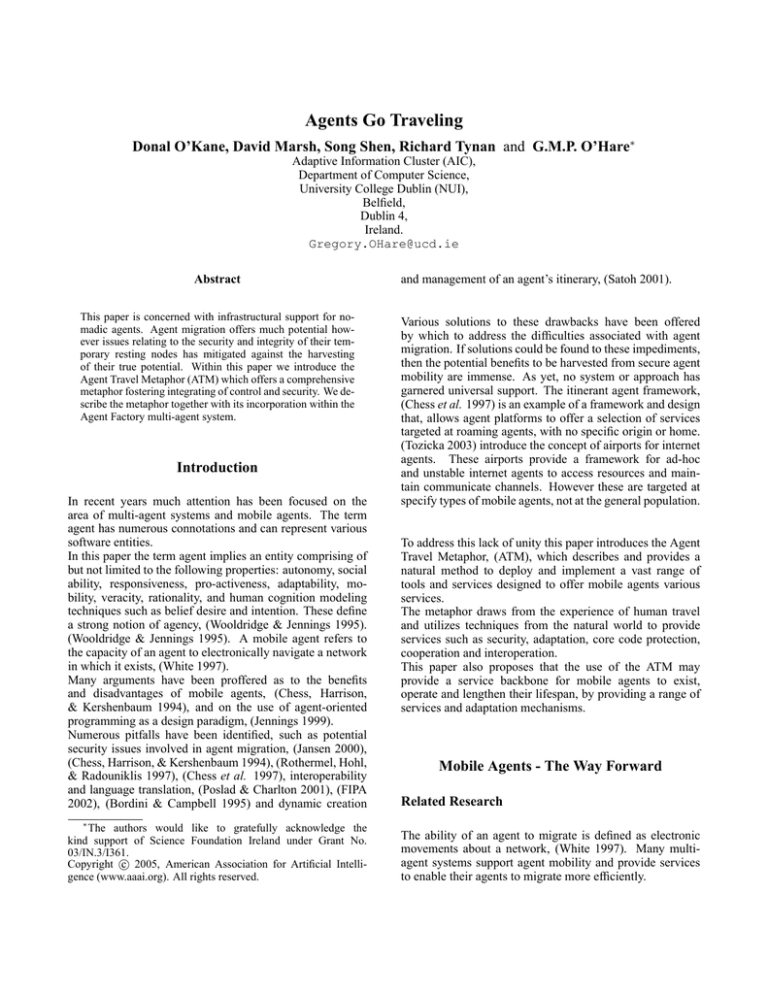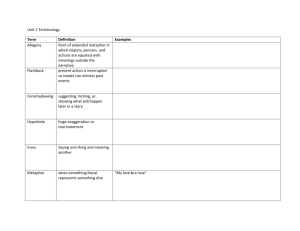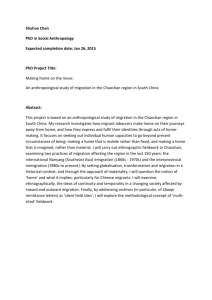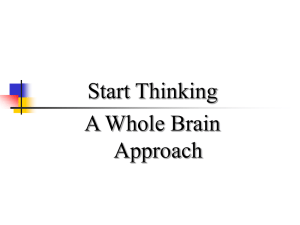
Agents Go Traveling
Donal O’Kane, David Marsh, Song Shen, Richard Tynan and G.M.P. O’Hare∗
Adaptive Information Cluster (AIC),
Department of Computer Science,
University College Dublin (NUI),
Belfield,
Dublin 4,
Ireland.
Gregory.OHare@ucd.ie
Abstract
This paper is concerned with infrastructural support for nomadic agents. Agent migration offers much potential however issues relating to the security and integrity of their temporary resting nodes has mitigated against the harvesting
of their true potential. Within this paper we introduce the
Agent Travel Metaphor (ATM) which offers a comprehensive
metaphor fostering integrating of control and security. We describe the metaphor together with its incorporation within the
Agent Factory multi-agent system.
Introduction
In recent years much attention has been focused on the
area of multi-agent systems and mobile agents. The term
agent has numerous connotations and can represent various
software entities.
In this paper the term agent implies an entity comprising of
but not limited to the following properties: autonomy, social
ability, responsiveness, pro-activeness, adaptability, mobility, veracity, rationality, and human cognition modeling
techniques such as belief desire and intention. These define
a strong notion of agency, (Wooldridge & Jennings 1995).
(Wooldridge & Jennings 1995). A mobile agent refers to
the capacity of an agent to electronically navigate a network
in which it exists, (White 1997).
Many arguments have been proffered as to the benefits
and disadvantages of mobile agents, (Chess, Harrison,
& Kershenbaum 1994), and on the use of agent-oriented
programming as a design paradigm, (Jennings 1999).
Numerous pitfalls have been identified, such as potential
security issues involved in agent migration, (Jansen 2000),
(Chess, Harrison, & Kershenbaum 1994), (Rothermel, Hohl,
& Radouniklis 1997), (Chess et al. 1997), interoperability
and language translation, (Poslad & Charlton 2001), (FIPA
2002), (Bordini & Campbell 1995) and dynamic creation
and management of an agent’s itinerary, (Satoh 2001).
Various solutions to these drawbacks have been offered
by which to address the difficulties associated with agent
migration. If solutions could be found to these impediments,
then the potential benefits to be harvested from secure agent
mobility are immense. As yet, no system or approach has
garnered universal support. The itinerant agent framework,
(Chess et al. 1997) is an example of a framework and design
that, allows agent platforms to offer a selection of services
targeted at roaming agents, with no specific origin or home.
(Tozicka 2003) introduce the concept of airports for internet
agents. These airports provide a framework for ad-hoc
and unstable internet agents to access resources and maintain communicate channels. However these are targeted at
specify types of mobile agents, not at the general population.
To address this lack of unity this paper introduces the Agent
Travel Metaphor, (ATM), which describes and provides a
natural method to deploy and implement a vast range of
tools and services designed to offer mobile agents various
services.
The metaphor draws from the experience of human travel
and utilizes techniques from the natural world to provide
services such as security, adaptation, core code protection,
cooperation and interoperation.
This paper also proposes that the use of the ATM may
provide a service backbone for mobile agents to exist,
operate and lengthen their lifespan, by providing a range of
services and adaptation mechanisms.
Mobile Agents - The Way Forward
Related Research
∗
The authors would like to gratefully acknowledge the
kind support of Science Foundation Ireland under Grant No.
03/IN.3/I361.
c 2005, American Association for Artificial IntelliCopyright gence (www.aaai.org). All rights reserved.
The ability of an agent to migrate is defined as electronic
movements about a network, (White 1997). Many multiagent systems support agent mobility and provide services
to enable their agents to migrate more efficiently.
A diversity of enabling technologies have been adopted in
order to underpin agent mobility. These include mobility
security measures, agent language translation, middle
agents, load balancing mechanisms, ad-hoc network tools
and agent code protection.
Mobility Security measures: Systems have been developed
that utilize passport and visa documents and digital certificates, (Guan, Wang, & Ong 2003), (Chess et al. 1997), to
enable identification and the origin of migrating agents.
Agent language translation: There are services and agents
that facilitate interoperation between heterogenous multiagent systems, using meta languages, (Bordini & Campbell
1995), direct translation, (Chess et al. 1997), or through the
use of ontologies,(FIPA 2002).
Middle agents: These agents provide a variety of static services to mobile agents such as naming and access to shard
resources, (Decker, Sycara, & Williamson 1997), (Chess et
al. 1997).
Load balancing mechanisms: Tools and services that provide load balancing for their network have been developed,
(Cao, Wang, & Das 2004).
Ad-hoc network tools: The ad-hoc nature of ever changing networks presents another massive set of problems for
a mobile agent environment. For example, node disappearance and sudden unannounced reappearance causes a serious
failure and recovery discovery problem. Nodes that fail are
no longer reachable, agents executing on such nodes are also
no longer reachable. Any dependant agents or services must
either have the ability to handle this failure or be notified of
its occurrence. Upon recovery or re-establishment of a node
connection, the other nodes or entities must be made aware
of the recovery, this is a non-trivial problem, (Tozicka 2003).
Agent code protection: Protection for the core of an agents
mental state against viral code and unauthorized access has
been developed, (Karnik & Tripathi 1998). Agent platform
administrators can assume benevolence of known agents
once their critical code is protected.
The Agent Travel Metaphor
The Agent Travel Metaphor, (ATM) adopted and introduced within this paper, borrows heavily from human travel.
It consolidates and expands previous work by other researchers that have adopted components and segments of the
overall travel scenario.
The variety of processes that we go through when we undertake a journey is unique for every journey and yet distinct
patterns can be extracted. Figure 1 shows a general set of
process that occur when undertaking travel.
Three classes of travel can been identified as useful for
mobile agents, International travel, National travel and
Metropolitan travel. In the human environment these classes
of travel all possess diverse procedures that determine issues
such as how travel is initiated, how secure the travel is and a
plethora of further services provided for the travelers.
Begin
Select Destination
Get Destination Description
if( ! same language ){
Contract Translator
}
if( ! same behavior ){
Contract Teacher
}
Determine Packing Requirements
if( packing necessary){
Pack Baggage
}
Obtain Necessary Travel Documents
Submit Travel document to Port Authority
Migrate once Authorized
End
// (a)
// (b)
// (c)
// (d)
// (e)
// (f)
// (g)
// (h)
// (i)
Figure 1: The agent travel algorithm.
In the metaphor, agents play the role of travelers, an
evolution from the human travel analogy, as agents are
typified by their use of human cognition techniques in their
decision making process.
Accordingly, agent platforms play the role of cities, also
a natural evolution from the travel analogy as an agent
platform is the location in which an agent exists and
interacts with its surrounding environment. The potential
for agent platforms to create federations with groups of
agent platforms and the analogous relationships between
neighboring cities and countries, e.g. countries that have
travel agreements and do not require visitors to apply for a
visa to enter. This reinforces the previous argument in favor
of the metaphor.
The ATM is designed to facilitate configuration and policing
of mobile agents policies and services in a heterogenous
environment.
The algorithm described in Figure 1 proposes a foundation
for a framework, providing agent platforms, and their
agents, with modular, secure, agile and adaptive agent
mobility services. The provision of these services, allows
for a flexible and easily configured environment, giving
platforms the capability to create affiliations with other
platforms and multi-agent networks.
Important Actors and Data Structures within the
Agent Travel Metaphor
In order to implement an initial realization of the agent
travel metaphor and its accompanying framework for
incorporation within Agent Factory, it is first necessary
to define some of the principle actors and data structures
necessary to support the metaphor.
Passport an official certificate proving an agents identity, issued by a trusted source.
Ticket a certificate that the ticket holder has paid for and
is entitled to a specific service.
Ticket Issuer a trusted agent or service that can be
contracted to provide travel tickets.
Visa a certificate proving that an agent is permitted to
migrate to a destination, issued by the destination.
Vaccinations a security and protection measure that
allows agents to defend themselves from infections
before migrating to a potentially dangerous/malicious
location as well as allowing agent platforms to guard
themselves from unknown migrating agents.
Port a conceptual location at which all migration to and
from an agent platform is coordinated.
Port Authorities a trusted agent or service charged with
the task of operating the port. The responsibilities
of this agent include coordinating agent migration,
upholding the local security policies and validating
tickets, visas and passports.
Air Side a restricted area of an agent platform. Once An
agent commences migration it is restricted from normal
operation until it arrives landside at its destination.
Land Side the term used for the normal space for agent
operation.
Baggage a collection of code or data, external to an
agent’s mental state, that the agent makes use of in
order to fulfil its goals.
Secure Box a secure and private storage location attached to a port. An agent carrying baggage may
deem portions unnecessary for the current location.
These unnecessary portions can be stored ready to be
retrieved once the agent requires them or leaves the
current location.
Language Translator an agent that can be contracted
by a mobile agent to bestow the ability to converse
with other agents that use different communication
languages.
Behavior Teacher an agent that can be contracted to
give an agent the ability to adapt to local operating
behaviors. Some platforms within the network may
require agents to register with its white/yellow pages
services for example, while other locations may not.
Visa
Passport
+visaID : int
+visaIssuer : AgentID
+passportID : String
+agentID : AgentID
+destination : PlatformAddress
+visaIssueDate : TimeStamp
+visaExpirationDate: TimeStamp
+outBoundStamp : TravelStamp
+inBoundStamp : TravelStamp
+travelOrganiser : AgentID
+passportID : int
+agentID : AgentID
+passportIssuer : AgentID
+passportIssueDate: TimeStamp
+passportExpirationDate : TimeStamp
+entryStamps : TravelStamp[]
+exitStamps : TravelS tamp[]
Figure 2: The Visa and Passport Data Structures.
Ticket
TravelStamp
+ticketID : int
+ticketIssuer : AgentID
+agentID : AgentID
+agentName : String
+agentAddress : PlatformAddress
+passportID : int
+visaID : int
+migrationMethod : String
+origin : PlatformAddress
+destination : PlatformAddress
+departureDate : TimeStamp
+arrivalDate : TimeStamp
+price : int
+timeStamp : TimeStamp
+platformAddress : PlatformAddress
AgentID
+agentName : String
+agentAddress : PlatformAddress
PlatformAddress
TimeStamp
+IPAddress : String
+port : int
+date : String
Figure 3: The Ticket, TravelStamp, AgentID, PlatformAddress and TimeStamp Data Structures.
Agent Factory and the Agent Travel Metaphor
Agent Factory Mobility Support
Agent Factory, (Collier et al. 2003), is a multi-agent systems developed using the strong notion of agency. Agent
Factory provides support and infrastructures that allow for
rapid prototyping of agents. It imbues its agents with mobility via HTTP socket connections, transferring agent mental
state and serialized java code. Federations of agent management services, (AMS), and directory facilitators, (DF),
provide white and yellow pages services that supply agent
and service naming.
Enabling Agent Factory with the ATM
In order to evaluate the usefulness of the agent travel
metaphor, we identified and extracted a subset of this architecture to be initially implemented. This subset consists of
the operations (a), (g), (h) and (i) defined in Figure
1. These operations give rise to the creation of three middle
agents and three key data structures.
TravelAgent
(1)
TravelOrganiser
PassportAuth
PortAuth:Dest
PortAuth:Origin
requestPassport()
boolean: passportRequestAccepted()
requestTicket()
(2)
requestVisa()
boolean: visaRequestAccepted()
boolean:Message1()
ticketRequestAccepted()
(3)
requestTravelApproval()
authenticateVisa()
boolean: visaValid()
authenticatePassport()
boolean: passportValid()
authenticateTicket()
Figure 5: A PortAuthority agent receiving a migration
request from a migrating agent, TravellingAgent, the
PortAuthority agent handles this request by firstly verifying
the documents legitimacy with the issuers.
boolean: ticketValid()
boolean: travelRequestAccpeted()
(4)
requestStartMigration()
requestStartMigration()
startMigrationAccepted()
boolean: startMigrationRequestAccepted()
Figure 4: UML interaction diagram show the 5 implemented
agents from the agent travel metaphor and the sequence of
messages that occur when an agent migrates using the passport, visa and ticket system of authentication.
The middle agents, TravelOrganiser, PassportAuthority and
PortAuthority are responsible for issuing the data structures,
Tickets, Passports and Visas, Figure 3 and Figure 2 respectively. Along with this responsibility for issuing travel documents to traveling agents, Figure 4 sections (1) and (2),
the middle agents also must provide a verification service
should another inspecting agent wish to make certain that a
presented travel certificate is valid, Figure 4 section (3).
In conjunction with providing a verification service for Visa
documents, PortAuthority agents are responsible for initiating authentication of incoming and outgoing agents’ travel
documents, Figure 4 section (3).
Modular Deployment of the Agent Travel
Metaphor
The use of middle agents to imbue an agent platform with
the ATM takes advantage of the flexibility inherent in intelligent agents, giving rise to the modular nature of the
metaphor.
The middle agents, for example the PortAuthority agent, can
use locally written software to perform their tasks. This
means that the exact protocols that the agents use to enforce
Figure 6: A PortAuthority agent receiving a migration request from a migrating agent, TravellingAgent, the PortAuthority agent handles this request by firstly verifying the documents legitimacy with the issuers.
their security policies can be defined by a local developer or
administrator.
Consider the following scenario: An administrator controls
a particular set of five agent platforms. The administrator
knows that agent language and behavior are identical across
all of the platforms and that only one of the platforms has
access to critical assets that need to be protected.
The administrator instructs the critical platform’s PortAuthority agent to demand that incoming migrating agents
present Ticket, Passport and Visa documents. Furthermore
it must scrutinize presented travel documents aggressively,
verifying them with their issuers along with performing a
query to federated PortAuthority agents to ensure that the
migrating agent or its origin has not been blacklisted or quarantined for misbehavior.
The administrator can set much looser security policies on
migration schedules on the network.
Migration time: The actual time taken to electronically
migrate an agent increases from 5% to 7%, as a result of the
agent keeping a record of its travel documents.
Total time taken, from deciding to initiate a migration to
completion, is substantially increased by 50% to potentially
greater than 300%. The percentage increase can be apportioned to the possibility of a large increase in the number
of agents that are involved in any migration event. In the
examples described above and seen in Figure 4, four agents
are involved in the migration process and the number of
messages passed increases from 6 without ATM to 19 in the
outlined example.
Figure 7: A TravelOrganiser agent receiving a validation request on a Ticket that was issued by this TravelOrganiser.
The agent compares the requested ticket against its records.
the other platforms, as security threats are not as potentially
catastrophic and damaging to these platforms. The administrator instructs these PortAuthorities to require a Passport
and Ticket from incoming migrating agents and to assume
agent benevolence, i.e. to accept all presented documents as
valid without verifying the documents with their issuer.
The above scenario describes the manner in which agent
platforms can be configured in different manners using the
ATM and the concepts of International travel and Metropolitan travel outlined in the Agent Travel Metaphor section
above.
Evaluation and Results
In order to evaluate the consequences of enabling Agent
Factory with the ATM framework we must consider several
issues.
Security: The ATM framework puts into place a configurable set of security measures that allow administrators
to set security policies in the manner that they see fit.
Figure 5 and Figure 6 show a PassportAuthority agent and
a PortAuthority agent respectively, these agents have been
configured to provide a high level of security and can easily
be altered to provide a slackened security policy.
Dynamic itinerary: The TravelOrganiser agent provides
mobile agents with a method to choose their migration
destination without any previous knowledge the location
of this platform. This allows agents to create a random
migration pattern incorporating new additions to the agent
platform network.
Scheduled migration: When an agent purchases a Ticket,
the destination agent platform is informed that an agent
wishes to migrate by the Ticket issuer. The origin and
destination PortAuthority agents can prepare for the migration event and utilize the time beforehand to modifying the
It is the opinion of the authors that the benefits obtained
from imbuing an Agent Factory agent platform with the
ATM outweigh the drop in performance and speed. The
additional services, such as security, heterogeneity over
agent language, behavior, come at a cost. The total time
taken for migration to occur and total size of an agent
when it is migrated is increased. The modular nature of the
ATM however allows for flexibility, for example if speed of
migration is a priority, then migration security polices can
be set to the lowest levels, increasing performance. If agent
platform security is the priority then the resulting increase
in the time taken caused by stricter security is an acceptable
compromise.
Conclusion
This paper has introduced a comprehensive agent migration
protocol which it delivers through a set of collaborative
intelligent agents. The metaphor has been realized and
incorporated within Agent Factory. It represents a consolidation and integration of some previous research that has
adopted in part the travel metaphor.
The ATM has been realized in such a way as to support the
addition of further modular components and the adoption of
configurable local polices, for example baggage allowance,
visa issue, security clearance and interoperability between a
variety of regimes.
References
Bordini, R. H., and Campbell, J. A.
1995.
Anthropologically-based migration of agents: a new
approach to interoperability.
Cao, J.; Wang, X.; and Das, S. K. 2004. A framework of
using cooperating mobile agents to achieve load sharing in
distributed web server groups. Future Gener. Comput. Syst.
20(4):591–603.
Chess, D.; Grosof, B.; Harrison, C.; Levine, D.; Parris, C.;
and Tsudik, G. 1997. Itinerant agents for mobile computing. In Huhns, M. N., and Singh, M. P., eds., Readings
in Agents. San Francisco, CA, USA: Morgan Kaufmann.
267–282.
Chess, D.; Harrison, C.; and Kershenbaum, A. 1994. Mobile Agents: Are They a Good Idea? Technical Report
RC 19887 (December 21, 1994 - Declassified March 16,
1995), IBM, Yorktown Heights, New York.
Collier, R. W.; O’Hare, G. M. P.; Lowen, T. D.; and
Rooney, C. 2003. Beyond prototyping in the factory of
agents. In Multi-Agent Systems and Applications III, 3rd
International Central and Eastern European Conference
on Multi-Agent Systems, CEEMAS 2003, Prague, Czech
Republic, June 16-18, 2003, Proceedings, volume 2691 of
Lecture Notes in Computer Science, 383–393. Springer.
Decker, K.; Sycara, K.; and Williamson, M. 1997. Middleagents for the internet. In Proceedings of the 15th International Joint Conference on Artificial Intelligence.
FIPA, F. F. I. P. A. 2002. Fipa abstract architecture specification.
Guan, S.-U.; Wang, T.; and Ong, S.-H. 2003. Migration
control for mobile agents based on passport and visa. Future Gener. Comput. Syst. 19(2):173–186.
Jansen, W. 2000. Countermeasures for mobile agent security.
Jennings, N. R. 1999. Agent-oriented software engineering. In Garijo, F. J., and Boman, M., eds., Proceedings
of the 9th European Workshop on Modelling Autonomous
Agents in a Multi-Agent World : Multi-Agent System Engineering (MAAMAW-99), volume 1647, 1–7. SpringerVerlag: Heidelberg, Germany.
Karnik, N. M., and Tripathi, A. R. 1998. Design issues in
mobile-agent programming systems. IEEE Concurrency
6(3):52–61.
Poslad, S., and Charlton, P. 2001. Standardizing agent
interoperability: the fipa approach.
Rothermel, K.; Hohl, F.; and Radouniklis, N. 1997. Mobile
agent systems: What is missing? In International Working
Conference on Distributed Applications and Interoperable
Systems DAISY97, 111–124. Chapman & Hall.
Satoh, I. 2001. Application-specific routing for mobile
agents. In Proceedings of International Conference on
Software Engineering, Artificial Intelligence, Networking
& Parallel Distributed Computing. ACIS.
Tozicka, J. 2003. Airports for agents: An open mas infrastructure for mobile agents. In Multi-Agent Systems and Applications III, 3rd International Central and Eastern European Conference on Multi-Agent Systems, CEEMAS 2003,
Prague, Czech Republic, June 16-18, 2003, Proceedings,
volume 2691 of Lecture Notes in Computer Science, 373–
382. Springer.
White, J. E. 1997. Mobile agents. In Bradshaw, J., ed.,
Software Agents, 437–472. AAAI/MIT Press, Menlo Park,
CA.
Wooldridge, M., and Jennings, N. R. 1995. Intelligent
agents: Theory and practice. The Knowledge Engineering
Review 10(2):115–152.



